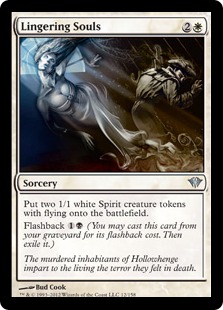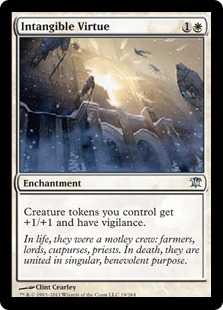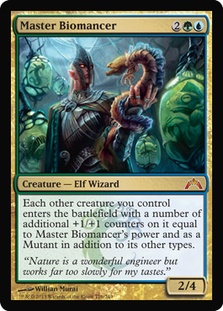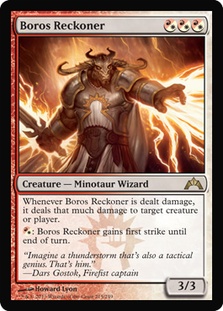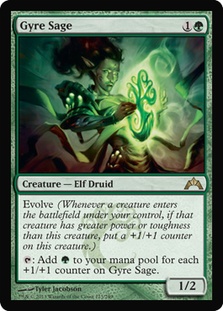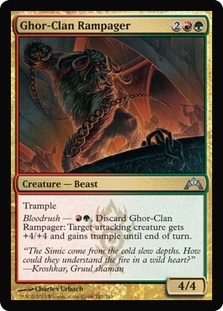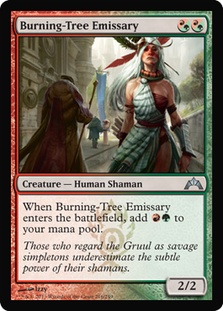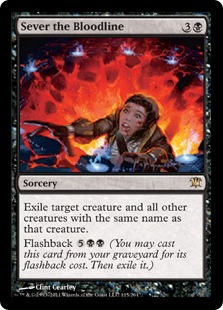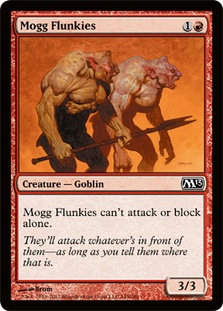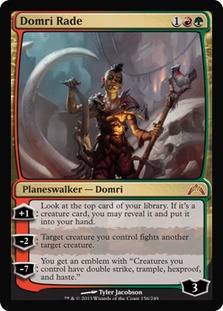Hello! Standard season is almost to its high tide, when SCG Opens will be joined by PTQs for the Pro Tour in Dublin and WMCQs for the World Magic Cup in Amsterdam (one of which will also be hosted by SCG, so watch out for its unbelievable success). The format is not going to stabilize completely, but the list of main contenders is probably defined. So it’s the proper time to figure out the format’s weak points and to brew something interesting. I’m not going to go crazy since I want to keep it real for the upcoming Grand Prix in Verona, but I’ve taken a look at the Gatecrash spoiler again and noticed some cards that were over- and underestimated.
This is a frustrating topic. No one wants to admit that they looked at the jewel and didn’t recognize it, but a second look may help identify why some cards didn’t perform well and what could help them to find their places in format. I said that the list of top contenders is already defined, but upcoming important events in a relatively stable field are great opportunities for rogue brews, some of which may easily become format staples. This may work for some hidden brews (look at Zvi Mowshowitz great series “Decks of Future Past” on Premium) or for old decks which got better (for example, Kessig Wolf Run in Bant Control was first seen in November).
Cards I always try when brewing from scratch in Standard right now are Lingering Souls and Intangible Virtue. This combination was powerful enough to be banned in Block Constructed but became hopeless in Standard. They are still good cards but are too slow for aggressive decks, while every midrange deck in format has the same problem: Jund does the same job better. So I tried Lingering Souls again with an updated mana base and with Master Biomancer (another overrated card). But all these three- and four-colored creations were worse than Jund, and W/B/R combining Lingering Souls with Hellrider was not fast enough to be called aggro. The best applications of Lingering Souls are still various control decks (which tend to use Supreme Verdict and Nephalia Drownyard instead of blocking and attacking) and The Aristocrats, where Intangible Virtue is useless.
Master Biomancer, as mentioned before, is very unlucky. This powerful card has no good applications due to a lack of a supportive shell. I’d be amazed to cast Boros Reckoner after Master Biomancer, but this is not supposed to work in Standard, so my endless attempts to build Saito Naya in RUG colors instead of Naya failed. Builds with Boros Reckoner simply didn’t work, while ones without the Minotaur were simply not powerful enough to compete in Standard. Huge bodies are bad against opposing Reckoners without trample effects and are equally vulnerable to Supreme Verdict. So I’m probably going to leave Master Biomancer alone until Dragon’s Maze; he’ll be the first old card I look at simultaneously with spoiler.
Another interesting card to brew with is Alms Beast. It’s not really underrated because it isn’t that good, but it’s an interesting card to think about. The biggest problem Alms Beast has is that it’s horrible against Boros Reckoner, but that could be mitigated by playing black. The real reason the Beast has been forgotten is that Mono-Black Control hasn’t appeared as a contender in this format. Conley Woods made Top 16 at Pro Tour Gatecrash with an inimitable creation (don’t try it at home), but his almost mono-black build was centered on another new card, Crypt Ghast, so expensive cards like Griselbrand and X spells like Rakdos’s Return (or Kessig Wolf Run if you’re fan of Travis Woo brews) made their way into the deck instead.
I’ve tried to incorporate my Innistrad favorite, Heartless Summoning, into this shell, but I eventually came to conclusion that it will not work without Solemn Simulacrum. So Alms Beast is probably in the huge cohort of “fine cards in an inappropriate environment,” while Crypt Ghast and company belong in the group of “you may like this deck and even play it but will never recommend it to anyone.” I’m sad that Mono-Black Control didn’t make it again, but, honestly, it’s not its time.
And finally, the card for which I’ve had the best expectations and which I completely missed, is Zameck Guildmage. It’s potentially powerful but is suited for a long game, whereas an aggressive deck has no chance against midrange despite any advantage that fragile 2/2 for two may produce. I’ll take a second look at Zameck Guildmage after Dragon’s Maze is released (it will probably be missed) and in October, when brand-new Standard will start (even though Strangleroot Geist will rotate out). Until then, two-mana creatures for aggressive decks should be either very fast (Burning-Tree Emissary) or very powerful (Gyre Sage).
Speaking of Gyre Sage, I’ve been very impressed by it and certainly believe it has bright future. Sage is bad as a late-game topdeck, but that’s also true for any one-mana creature in Standard while Gyre Sage is much more relevant than a 1/1 for one (except for cases of “topdeck Thundermaw Hellkite or lose”). The most appropriate comparison is Noble Hierarch. Hierarch is a mana dork with fine aggressive ability, whereas Gyre Sage is an aggressive creature that can occasionally produce mana. Yes, that’s the case.
Gyre Sage is not Tarmogoyf, but in the same fashion that Experiment One is not Wild Nacatl; both cards are not as fast as their predecessors, but they exist in a weaker environment and may grow out of control very fast. Experiment has already found its way into Modern, and although I don’t expect Gyre Sage to do so, a deck with both Experiment One and Gyre Sage may be very powerful. I definitely want to build one to exploit this pair. That leaves me without all-star Boros Reckoner, but it seems to be a fair exchange if the proper shell to grow evolving creatures can be found.
The primary color of the deck will definitely be green, and the second color will be determined by removal, especially removal to deal with Boros Reckoner—which leaves us with black and red as our only options. Red has no non-damaging removal, but a combination of Rancor, Kessig Wolf Run, and Ghor-Clan Rampager looks good enough to seal the deal. Our R/G deck takes the transitional place between Jund Aggro and Saito Zoo, combining the speed of the former and power of the latter. A similar deck recently did very well at SCG Standard Open: Las Vegas, putting two pilots into the Top 16.
Creatures (32)
- 4 Arbor Elf
- 4 Strangleroot Geist
- 4 Huntmaster of the Fells
- 4 Wolfir Silverheart
- 4 Flinthoof Boar
- 4 Burning-Tree Emissary
- 4 Ghor-Clan Rampager
- 4 Gyre Sage
Planeswalkers (3)
Lands (21)
Spells (4)

This list, unfortunately for me, doesn’t have Experiment One and has a very questionable mana curve—there are few good turn 2 plays if you have Arbor Elf. Additional questions are the lack of Rancor and Kessig Wolf Run maindeck and Searing Spear as the removal of choice. Such a deck is poorly positioned against Olivia Voldaren, and Mizzium Mortars has much more of a chance to deal with her. I understand that R/G has almost no chance to overload Mortars, but I’m fine with only the normal mode. I’d build R/G like this:
Creatures (29)
- 2 Arbor Elf
- 4 Strangleroot Geist
- 2 Wolfir Silverheart
- 2 Wolfir Avenger
- 3 Flinthoof Boar
- 4 Burning-Tree Emissary
- 4 Experiment One
- 4 Ghor-Clan Rampager
- 4 Gyre Sage
Planeswalkers (3)
Lands (22)
Spells (6)

The mana base is controversial since it’s hard to maintain the requirements of the one-drops and the red spells, especially Flinthoof Boar and Ghor-Clan Rampager, which can’t afford the help of Burning-Tree Emissary. However, it mostly works, even though I was forced to cut a pair of Arbor Elf. The list is relatively good at growing the evolving creatures to 3/3 and 3/4, respectively, and even though I anticipate some problems with Thragtusk, this deck is capable of competing with all Thragtusk decks, including Jund (which seems to be a slightly negative matchup anyway).
An important concern is the ability to play defensively against Naya Blitz. Heavier aggressive decks are generally more consistent and better-positioned than faster ones, but they too are bad at defense (you should take a look at Brian Kibler feature match in SCG Standard Open: Las Vegas coverage, when his B/G Ooze deck was forced to outrace Mono-Red Aggro despite being supposedly in the control role). Pillar of Flame, Bonfire of the Damned, and Huntmaster of the Fells complement Mizzium Mortars in these matches, and don’t forget that Strangleroot Geist is great at blocking.
Another approach is to choose black over red. It immediately gives us better removal and some versatility, but it’s in exchange for Ghor-Clan Rampager and Domri Rade, which may be suboptimal. It’s similar to Brian Kibler G/B Ooze deck, but I’m aiming to build a heavier version that’s better at utilizing Gyre Sage. Let’s look at my attempt:
Creatures (30)
- 4 Arbor Elf
- 4 Strangleroot Geist
- 3 Wolfir Silverheart
- 3 Wolfir Avenger
- 4 Dreg Mangler
- 2 Deadbridge Goliath
- 2 Lotleth Troll
- 4 Experiment One
- 4 Gyre Sage
Lands (20)
Spells (10)

The lack of Burning-Tree Emissary may slow down our nut draws, but Experiment One is still capable of growing enough, while Gyre Sage is great at making mana for various expensive options like Wolfir Avenger, Sever the Bloodline’s flashback, scavenging our creatures, and protecting Wolfir Avenger from Searing Spear and Supreme Verdict.
This list looks fast enough to compete with Jund (after playing Naya, I highly enjoy casting Sever the Bloodline into Olivia Voldaren) and versatile enough to be good in defensive mode. However, there’s always the temptation to splash a third color (especially when there’s no Predator Ooze to restrict us). But White only gives us Loxodon Smiter, who is enjoyable but not enough to justify splashing; Blue is useless since deck just has no place for Master Biomancer. Red would be the most interesting, but when I tried to combine previous lists, I inevitably came to a list very close to Ari Lax Experiment Jund.
Creatures (31)
- 2 Arbor Elf
- 4 Falkenrath Aristocrat
- 1 Wolfir Silverheart
- 4 Flinthoof Boar
- 4 Dreg Mangler
- 4 Burning-Tree Emissary
- 4 Experiment One
- 4 Ghor-Clan Rampager
- 4 Gyre Sage
Planeswalkers (2)
Lands (22)
Spells (5)

The difference is essentially Arbor Elf and Gyre Sage, and they are both not as impressive here as I would like them to be. I particularly enjoy Mogg Flunkies and think it fits perfectly in Experiment Jund, but Gyre Sage has much more potential in the right shell, which is what I’m trying to figure out. Domri Rade instead of Searing Spear is also debatable since his fight ability is far less impressive than in Saito Zoo filled with Loxodon Smiter and Boros Reckoner, but the Gruul planeswalker is almost fine here.
I’ve just started building this list and am still not sure if it’s better than Ari’s version, but that’s the nature of brewing—it’s not always successful, but it helps us to understand the format and other opportunities, so I present this half-finished attempt without fear. Constructive criticism and discussion of ideas are the best ways to improve the list. So I hope these thoughts will be useful for you and that readers’ feedback will help improve these creations. Good luck to everyone playing at SCG Open Series: Indianapolis and Grand Prix Rio de Janeiro, and I’ll see those of you who are going to attend Grand Prix Verona soon. I’m looking forward to leaving my lair in Moscow and going to warmer places for two weeks, so don’t be afraid to say “Hi!” if you see me there.

